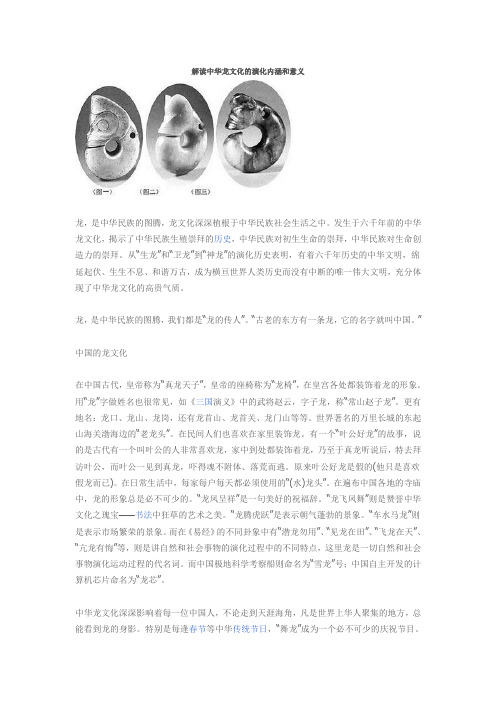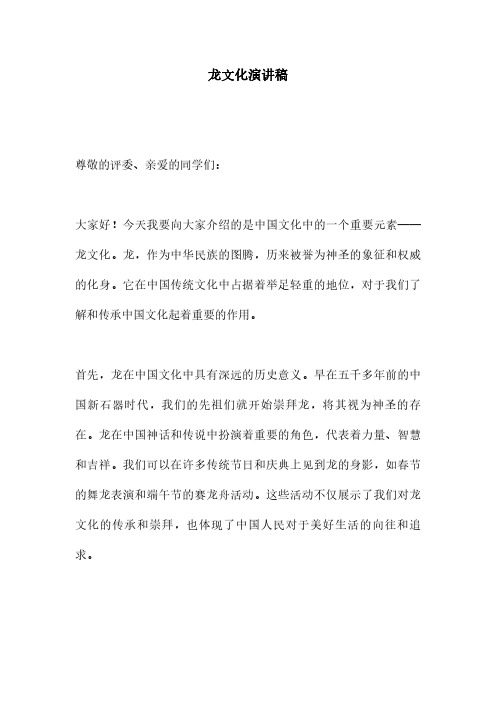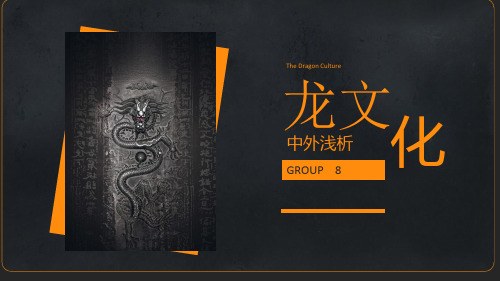Dragon Culture 龙文化
龙文化的简介

龙文化的简介Introduction to Dragon Culture龙文化简介Dragon culture is a profound and rich cultural phenomenon that has been deeply ingrained in the hearts of the Chinese people for thousands of years.龙文化是一种深刻而丰富的文化现象,数千年来深深植根于中国人民的心中。
The dragon, as a mythical creature, symbolizes auspiciousness, power, and dignity in Chinese culture.在中国文化中,龙作为神话生物,象征着吉祥、力量和尊严。
It is often depicted as a powerful beast with scales, claws, and a fiery breath, capable of controlling the rain and winds.龙常被描绘为具有鳞片、爪子和火焰气息的强大生物,能够掌控风雨。
The dragon is also a popular motif in Chinese art and architecture, appearing in paintings, sculptures, and even in the design of temples and palaces.龙也是中国艺术和建筑中的流行元素,出现在绘画、雕塑中,甚至在寺庙和宫殿的设计中也能见到它的身影。
Moreover, dragon dances and festivals are common throughout China, celebrating the auspicious spirit of the dragon and promoting cultural unity.此外,中国各地都盛行舞龙和龙节,庆祝龙的吉祥精神,促进文化团结。
解读中华龙文化的演化内涵和意义

解读中华龙文化的演化内涵和意义龙,是中华民族的图腾,龙文化深深植根于中华民族社会生活之中。
发生于六千年前的中华龙文化,揭示了中华民族生殖崇拜的历史,中华民族对初生生命的崇拜,中华民族对生命创造力的崇拜。
从“生龙”和“卫龙”到“神龙”的演化历史表明,有着六千年历史的中华文明,绵延起伏、生生不息、和谐万古,成为横亘世界人类历史而没有中断的唯一伟大文明,充分体现了中华龙文化的高贵气质。
龙,是中华民族的图腾,我们都是“龙的传人”。
“古老的东方有一条龙,它的名字就叫中国。
”中国的龙文化在中国古代,皇帝称为“真龙天子”,皇帝的座椅称为“龙椅”,在皇宫各处都装饰着龙的形象。
用“龙”字做姓名也很常见,如《三国演义》中的武将赵云,字子龙,称“常山赵子龙”。
更有地名:龙口、龙山、龙岗,还有龙首山、龙首关、龙门山等等。
世界著名的万里长城的东起山海关渤海边的“老龙头”。
在民间人们也喜欢在家里装饰龙。
有一个“叶公好龙”的故事,说的是古代有一个叫叶公的人非常喜欢龙,家中到处都装饰着龙,乃至于真龙听说后,特去拜访叶公,而叶公一见到真龙,吓得魂不附体、落荒而逃。
原来叶公好龙是假的(他只是喜欢假龙而已)。
在日常生活中,每家每户每天都必须使用的“(水)龙头”。
在遍布中国各地的寺庙中,龙的形象总是必不可少的。
“龙凤呈祥”是一句美好的祝福辞。
“龙飞凤舞”则是赞誉中华文化之瑰宝——书法中狂草的艺术之美。
“龙腾虎跃”是表示朝气蓬勃的景象。
“车水马龙”则是表示市场繁荣的景象。
而在《易经》的不同卦象中有“潜龙勿用”、“见龙在田”、“飞龙在天”、“亢龙有悔”等,则是讲自然和社会事物的演化过程中的不同特点,这里龙是一切自然和社会事物演化运动过程的代名词。
而中国极地科学考察船则命名为“雪龙”号;中国自主开发的计算机芯片命名为“龙芯”。
中华龙文化深深影响着每一位中国人,不论走到天涯海角,凡是世界上华人聚集的地方,总能看到龙的身影。
特别是每逢春节等中华传统节日,“舞龙”成为一个必不可少的庆祝节目。
龙文化

有 的 九 个 头
中 国 的 龙 与 西 方 的 龙 有 西 的 方 三 龙 个 的 头 龙 头 比 较 多
龙是以蛇为主体的图腾
Loong is the totem of Chinese nation, originated in ancient time. The image of loong comes from snake.
中国龙文化
Dragon culture of China
中国的龙文化
中国的神话与传说中,龙是一种神异动 物,其形象有多种,在阴阳宇宙观中代表 阳,是中华民族的象征和古代王室的标志。 华夏民族的先祖炎帝、黄帝,传说中和龙 都有密切的关系。相传炎帝为其母感应 “神龙首”而生,死后化为赤龙。因而中 国人自称为“龙的传人”。而西方神话中 dragon,也翻译成龙,但二者并不相同 。
中国龙的历史
The History of Dragon 1987年在河南濮阳发掘了 一处距离今天6000多年仰 韶文化早期的大墓,在男 性墓主人身边出土了一条 用蚌壳堆塑的龙,这是目 前我们见到的最早的龙, 人称“中华第一龙”
在内蒙古还出土了一个玉 龙,样子很漂亮,它的身体 细长,弯曲成C形,龙头很像 猪,这个猪头形的玉龙也有 5000多年的历史了。
寓意:在关键地方简明扼要地点明要旨,使内容生动传神。
谢 谢 观 看
The dragon of art
龙的艺术字
The dragon art words
龙的画
The dragon painting
龙的雕刻
The dragon sculpture
龙的艺术字 (The dragon art words)
•龙的画(The dragon painting)
龙文化演讲稿

龙文化演讲稿尊敬的评委、亲爱的同学们:大家好!今天我要向大家介绍的是中国文化中的一个重要元素——龙文化。
龙,作为中华民族的图腾,历来被誉为神圣的象征和权威的化身。
它在中国传统文化中占据着举足轻重的地位,对于我们了解和传承中国文化起着重要的作用。
首先,龙在中国文化中具有深远的历史意义。
早在五千多年前的中国新石器时代,我们的先祖们就开始崇拜龙,将其视为神圣的存在。
龙在中国神话和传说中扮演着重要的角色,代表着力量、智慧和吉祥。
我们可以在许多传统节日和庆典上见到龙的身影,如春节的舞龙表演和端午节的赛龙舟活动。
这些活动不仅展示了我们对龙文化的传承和崇拜,也体现了中国人民对于美好生活的向往和追求。
其次,龙文化在中国人的精神世界中具有深刻的影响。
龙被视为是我们的先祖,代表着中国人民的血脉和家族。
在中国传统思想中,龙还被赋予了吉祥、辟邪、保护和灵感的象征意义。
龙是我们民族精神的象征,也是我们民族自豪感的象征。
正因为有了龙文化的滋养和庇佑,我们才能在千百年间保持着自己独特的文化特色,不断发展和进步。
此外,龙文化还具有丰富的艺术表现形式。
在中国传统绘画中,龙常常作为主题出现,以其恢弘的气势和生动的形象赢得了世人的赞美。
无论是古代的壁画、绘画作品,还是现代的书法和篆刻作品,都能看到龙的身影,展示了中国人对龙文化的热爱和崇敬。
此外,在传统文学、戏曲和音乐中,龙的形象也被广泛运用,为我们呈现出一幅幅精彩纷呈的艺术画面。
龙文化不仅仅是中国文化的一部分,更是中华民族的象征和精神支柱。
作为新时代的青年,我们应该自觉地传承和弘扬龙文化,让它在现代社会中焕发出新的生命力。
我们应该以龙为榜样,努力追求卓越,展现出中国人民的智慧和勇气。
我们应该像龙一样,勇往直前,不断奋进,为实现中华民族的伟大复兴贡献自己的力量。
最后,我想引用孔子的一句名言来结束我的演讲:“君子之行,静以修身,俭以养德,非淡泊无以明志,非宁静无以致远。
”龙文化给予我们智慧和力量,我们应该在实现自身价值的同时,秉持着对国家和社会的热爱,为建设美好的世界贡献自己的一份力量。
龙文化剪纸艺术英文作文

龙文化剪纸艺术英文作文English:Dragon culture has a rich tradition of paper-cutting art, a delicateand intricate craft that has been passed down through generations. The dragon, as a symbol of power, strength, and good fortune in Chinese culture, is often depicted in paper-cutting with its bold and dynamic imagery. The dragon's form is carefully outlined and meticulously cut from a single piece of paper, creating a stunningand intricate design. This traditional art form not only showcases the skill and patience of the artist but also serves as a meaningful way to express cultural values and beliefs. The dragon paper-cutting art has become an important part of Chinese cultural heritage, playing a significant role in festivals, celebrations, and everyday life.中文翻译:龙文化有着丰富的剪纸艺术传统,这是一种经过多代人传承的精细、复杂的手艺。
在中国文化中,龙作为力量、坚毅和好运的象征,经常以剪纸形式展现其大胆而动态的形象。
中国文化英文PPT之龙文化dragon-culture-in-China复习课程

Definition of Dragon
Dragon cultures exit in both the Eastern and Western world. However, there are totally different connotations under the different culture backgrounds.
The Chinese even have a year of
the dragon, and it is said that anyone born in this year will be healthy, wealthy, and wise.
Cautious Usage of “Dragon”
Some scholars believe that they can be distinguished in spelling. English one is spelled as “dragon” while the Chinese one as “loong”. However, the ideas have not been in broad agreement so far.
Great attention is required when the word “dragon” comes into use.
1. A person is like a dragon.----not a compliment at all.
2. If you call a woman a dragon ---- she is fierce and unpleasant. 3. She is a bit a dragon around here. ----She is a domineering woman.
Chinese Dragon Culture 龙文化 (1)

Chinese Dragon Culture 龙文化Many Chinese people like to sing a song : “There is a dragon in the ancient orient whose name is China. There is a group of ancient oriental people there too, who are all the descendants of the dragon…” Here the word “dragon’ is the symbol of Chinese nation. Many foreigners call China the “oriental dragon”. Chinese people also like to call themselves the “descendants of the dragon”.很多中国人都爱唱这样一首歌:“古老的东方有一条龙,它的名字就叫中国;古老的东方有一群人,他们全都是龙的传人。
”这里所说的龙是中华民族的象征。
很多外国人也称中国为“东方巨龙”。
中国人更喜欢称自己为“龙的传人”。
In fact, “dragon” is only a kind of imaginary animal in legend. No one has ever seen the flying dragon winding through the clouds in China or anywhere else. It is the mysterious dragon worship, especially the worship of the snake totem.实际上,龙只是一种传说中的虚拟动物。
在当今世界,在中国,没有人见过蜿蜒飞舞的龙。
这与神秘的龙崇拜有关,尤其与对蛇的图腾崇拜有关。
中外龙文化浅析讲课教案

totems
西方龙 简介
西方龙通常被想像成一只巨大的蜥蜴, 长着蝙蝠的翼、身披鳞片,有蛇一样的 舌头,能喷火;也有人把它想像成一条 大蛇,有带刺的尾巴。在中东世界,蛇 或龙都是邪恶的象征;埃及的阿佩皮神 就是冥界的一条蛇。希腊人和罗马人有 时把它看成是邪恶的力量,但有时也把 居住在大地深处目光锐利的龙看成是仁 慈的力量。在基督教,龙是罪和异教的 象征,因而在绘画中匍匐于圣徒与殉教 者足下。龙很早就被用来作为战争的标 志,北欧的战士把他们的船头刻成龙头 形,中世纪英国曾以龙为皇家的徽记。
龙的形象也出现在《圣经》中。在《启示录》 里,龙的形象是邪恶的,是撒但的化身。这 种形象也贯穿在各种基督教教义以及衍生的 文艺作品及文化中。早期的圣徒传中不乏圣 人与龙搏斗的事迹 。
圣经中的龙
古希腊神话
古希腊神话中的龙常常作为凶恶的怪 物以及宝物的看守者出现。荷马的史 诗《伊利亚特》中提到阿伽门农的装 束时说他的剑带上有蓝色龙形的图案, 他的胸甲上也有三头巨龙形象的纹饰。 在赫拉克勒斯的十二件功绩中,第十 一件“盗取金苹果”中守护金苹果的 也是龙。据伪阿波洛多罗斯的《书库》 第2册中描述,金苹果“由一条长生 不死的巨龙看守着。这头巨龙是堤丰 与艾奇德娜的后代,生有一百个头颅, 一百张嘴巴里发出一百种不同的声 音。”。许癸努斯的《传说集》中则 提到守护金苹果的龙拉冬是堤丰与艾 奇德娜的子女之一。它还有一个兄弟, 是守护金羊毛的龙。
The Dragon Cຫໍສະໝຸດ lture龙文 化 中外浅析
GROUP 8
Definition • A dragon is a legendary creature, typically with
serpentine(蛇形) or reptilian(爬虫类) traits, that features in the myths of many cultures.There are two distinct cultural traditions of dragons:the European dragon,derived from European folk traditions and ultimately related to Greek and Middle Eastern mythologies, and the Chinese dragon, with counterparts in Japan (namely the Japanese dragon),Korea and other East Asian countries.
龙文化英语简单介绍

龙文化英语简单介绍Title:The Dragon Culture.In Chinese culture, the dragon is regarded as an auspicious creature, symbolizing power, strength, and good luck. Dragons hold a significant position in traditional Chinese art, literature, and folklore. Chinese people believe that the dragon is a symbol of good fortune and can bring luck and happiness to people. Dragon dances and dragon performances are also an important part of traditional Chinese festivals, symbolizing prayers for a good harvest and auspiciousness. Dragon culture plays an important role in Chinese history and ethnic traditions, and is considered as one of the symbols of Chinese culture.中文翻译:龙文化。
龙在中国文化中被视为祥瑞之物,象征着权力、力量和好运。
龙在中国传统艺术、文学和民间传说中占据重要位置。
中国人相信龙是吉祥的象征,可以给人们带来好运和幸福。
龙舞和舞龙表演也是中国传统节日的重要组成部分,象征着祈求丰收和吉祥。
龙文化在中国历史和民族传统中扮演着重要的角色,被视为中国文化的象征之一。
龙的文化小知识

龙的文化小知识Dragons have long been a symbol of power, strength, and good fortune in Chinese culture. 龙在中国文化中长期以来一直是力量、力量和好运的象征。
They are revered creatures that are believed to bring luck, wealth, and protection to those who are deserving. 它们被尊敬为能为那些值得的人们带来幸运、财富和保护的生物。
In Chinese mythology, dragons are often depicted as benevolent beings who control the weather and seas. 在中国神话中,龙常被描绘为善良的存在,掌控着天气和海洋。
They are seen as divine creatures that have the ability to shape the world around them. 它们被视为神圣的生物,拥有塑造周围世界的能力。
Dragons also play a significant role in Chinese art and literature, with many ancient stories and paintings featuring these majestic creatures. 龙在中国艺术和文学中也扮演着重要的角色,许多古代故事和绘画都以这些威严的生物为特色。
Their presence symbolizes power, courage, and wisdom, inspiring generations of artists and writers. 它们的存在象征着力量、勇气和智慧,激励了一代又一代的艺术家和作家。
龙年的征文 传承中国龙文化开头

英文回复:The dragon, one of the key symbols of our traditional culture,is the symbol of peace and strength。
The dragon culture islong and can be traced back to ancient civilizations thousandsof years ago。
Our traditional festivals, drawings, literature,architecture and so on have profound implications for the dragon culture。
As an important part of our traditional culture,the dragon culture is of great importance, bearing in mind the sedimentation of history and national feelings。
Over time,the dragon culture has gradually be a symbol of the hearts of our people, representing the spiritual and cultural heritage of the Chinese nation。
We must continue to promote the flourishing of socialist culture that characterizes our country,strengthen its soft power—building and work to build a strong socialist culture。
龙文化研究内容

龙文化研究内容Dragons have been an integral part of Chinese culture for centuries. They are seen as symbols of power, strength, and good luck in Chinese mythology. 龙在中国文化中已经存在了几个世纪,它们被视为中国神话中的象征,象征着力量、力量和好运。
The dragon is often associated with the Emperor in Chinese culture, as it represents imperial power and authority. 龙在中国文化中常常与皇帝联系在一起,因为它代表着皇权和权威。
In Chinese festivals and celebrations, dragons are often seen in dragon dances, where performers mimic the movements of a dragon. 在中国的节日和庆典中,人们经常能看到舞龙表演,表演者模仿龙的动作。
Dragons are also believed to bring good fortune and protection, which is why they can be found on various items such as clothing, decorations, and architecture in China. 人们还相信龙可以带来好运和保护,这就是为什么他们可以在中国各种物品上找到,如服装、装饰品和建筑。
The influence of dragon culture is not limited to China, as it has spread to other East Asian countries such as Japan and Korea, where dragons are also revered and respected. 龙文化的影响不仅限于中国,它已经传播到其他东亚国家,如日本和韩国,那里龙也是受人尊敬和尊重的。
传承龙文化,争当龙传人得作文

传承龙文化,争当龙传人得作文英文回答:In order to inherit the dragon culture and become a dragon heir, it is essential to understand the significance and value of this ancient tradition. The dragon culture holds a deep-rooted place in Chinese history and has been passed down from generation to generation. As a dragon heir, I have a responsibility to preserve and promote thiscultural heritage.First and foremost, being a dragon heir means embracing the rich symbolism associated with dragons. In Chinese culture, dragons represent power, strength, and good fortune. They are believed to bring blessings and protect against evil spirits. By understanding and embodying these qualities, I can carry on the legacy of the dragon culture and inspire others to appreciate its beauty.Furthermore, as a dragon heir, it is important to studythe history and mythology surrounding dragons. Learning about the legends and stories associated with dragons allows me to deepen my understanding of their significance and share this knowledge with others. For example, the story of the Dragon Boat Festival, where dragon boats race to commemorate the ancient poet Qu Yuan, showcases the dragon's role in Chinese folklore and traditions.Moreover, being a dragon heir entails participating in dragon-related activities and events. Dragon dances, for instance, are a common sight during Chinese New Year celebrations. By actively engaging in these cultural practices, I not only preserve the dragon culture but also contribute to its visibility and appreciation in contemporary society.Additionally, as a dragon heir, I have the responsibility to pass on this cultural heritage to future generations. This can be achieved through education and awareness programs, where I can share the history, symbolism, and traditions of dragons with younger individuals. By instilling a sense of pride andappreciation for their cultural heritage, I can ensure the longevity and vitality of the dragon culture.In conclusion, being a dragon heir is more than just a title; it is a commitment to preserving and promoting the dragon culture. Through understanding the symbolism, studying the history and mythology, participating in dragon-related activities, and passing on this cultural heritage, I can contribute to the continuation and enrichment of this ancient tradition.中文回答:作为一个龙传人,传承龙文化对我来说至关重要。
龙文化的英语小短文

龙文化的英语小短文英文回答:Dragon Culture: A Cross-Cultural Exploration.Dragons, mythical creatures that have captivated human imagination for centuries, hold a prominent place in the cultural tapestry of many societies around the world. From the serpentine dragons of Chinese mythology to thefeathered serpents of Aztec lore, these magnificent beasts have inspired awe, fear, and fascination in equal measure.Origin and Symbolism.The origins of dragon mythology are shrouded in mystery, but the concept of a winged, fire-breathing creatureappears in cultures as diverse as ancient Egypt, Greece,and Mesopotamia. In many cultures, dragons were seen as symbols of power, wisdom, and chaos. They were often associated with natural forces, such as the sky, thunder,and storms.Cultural Variations.While dragons share certain characteristics across cultures, there are also significant variations in how they are depicted. In Chinese culture, dragons are typically portrayed as benevolent and wise creatures, often associated with wealth and prosperity. In Western cultures, on the other hand, dragons are often seen as fearsome and destructive, embodying the forces of evil.Dragons in Literature and Art.Dragons have been featured prominently in literature and art throughout history. From the epic battles of Beowulf to the whimsical tales of The Hobbit, these creatures have captured the imagination of writers and artists alike. In art, dragons have been depicted in a wide range of forms, from the intricate sculptures of ancient China to the canvases of medieval European painters.Modern Interpretations.In modern times, dragons continue to exert afascination on popular culture. They appear in movies, television shows, video games, and books. These contemporary depictions often draw inspiration from traditional mythology, but they also introduce new interpretations and variations. For example, the dragons in Game of Thrones are portrayed as powerful and dangerous creatures, while the dragons in How to Train Your Dragon are more friendly and playful.Conclusion.Dragon culture is a fascinating and multifaceted phenomenon that reflects the human fascination with the unknown and the powerful forces of nature. From ancient myths to modern interpretations, dragons continue to capture our imagination and inspire our creativity.中文回答:龙文化,跨文化探索。
龙在文化中的象征意义

龙在文化中的象征意义The dragon, a mythical creature with a long and serpentine body, has held profound symbolic significance in various cultures across the globe.In Eastern cultures, particularly in China, the dragon represents power, wisdom, and prosperity.It"s revered as a divine beast, embodying the forces of nature and the spirit of vitality.龙,这个有着长长蛇形身体的神秘生物,在全球各地的文化中都有着深刻的象征意义。
特别是在东方文化中,尤其是在中国,龙象征着权力、智慧与繁荣。
它被视为神圣的生物,蕴含着自然的力量与生机勃勃的精神。
Western lore often portrays the dragon as a fierce and malevolent being, guarding treasure and1;2licting destruction.However, in Eastern traditions, the dragon is seen as a benevolent guardian, bringing fortune and good luck.西方传说中,龙常常被描绘成凶猛而恶毒的生物,守护着宝藏并带来破坏。
然而,在东方传统中,龙被视为仁慈的守护者,带来好运和财富。
The dragon"s symbolism is deeply integrated into Chinese culture, where it serves as a symbol of imperial power and divine authority.The emperors of China were known to be the "sons of the dragon," illustrating their divine right to rule.龙的象征意义深深植根于中国文化中,它代表着皇权和神圣的权威。
写龙文化的英语作文

Dragon Culture: A Symbol of Power andGood LuckThe dragon, a mythical creature with a long and storied history in Chinese culture, has long fascinated people around the world. Its unique blend of power, wisdom, and good luck has made it a popular symbol in Chinese art, literature, and folklore. This essay delves into the rich tapestry of dragon culture, exploring its various representations and the profound meanings it holds for the Chinese people.In Chinese mythology, the dragon is often described as a serpentine creature with horns, scales, and claws. It is believed to possess the ability to control the elements, particularly water, and is often depicted as flying through the clouds or swimming in rivers and lakes. The dragon's association with water is significant, as water has always been a vital resource in Chinese culture, symbolizing life, fertility, and purity.The dragon is also regarded as a symbol of imperial power and authority in Chinese history. The emperor, considered the son of heaven, was often depicted wearingdragon robes and sitting on a dragon throne. This association was not arbitrary; the dragon's uniquequalities of strength, intelligence, and benevolence were seen as qualities that an ideal emperor should possess. As such, the dragon became a symbol of unity, stability, and prosperity for the Chinese people.However, the dragon's role in Chinese culture is not limited to imperial power and authority. It is also a symbol of good luck and prosperity in the lives of ordinary people. Many Chinese families decorate their homes with dragon motifs during festivals and special occasions, hoping to attract good fortune and positive energy. The dragon dance, a popular folk performance, is also seen as a way to祈求好运和驱逐邪恶力量。
中国龙文化的英语作文

中国龙文化的英语作文【中英文版】English Version:The Dragon Culture in ChinaThe dragon, an imaginary creature with the body of a serpent and the face of a camel, holds a unique and significant place in Chinese culture.It is not only a symbol of power, strength, and wisdom but also represents prosperity and good fortune.The dragon culture in China has a long history and has deeply influenced the Chinese people"s way of life.In ancient China, the dragon was believed to be the ruler of the sky and the controller of rainfall.Emperors were often referred to as "the sons of the dragon," symbolizing their divine power and authority.Dragons are frequently depicted in Chinese art, literature, and architecture, serving as a reminder of the nation"s rich cultural heritage.One of the most famous dragon-related traditions is the dragon dance, performed during Chinese New Year celebrations.Dragon dancers manipulate a long, colorful dragon costume, symbolizing the creature"s lively and powerful movements.This dance is believed to bring good luck and fortune to the community.Moreover, the dragon is one of the twelve animals in the Chinese zodiac.Those born in the year of the dragon are thought to be confident, intelligent, and ambitious.They are believed to possess the qualities ofleadership and are destined for greatness.Dragon imagery can also be found in various Chinese proverbs and idioms.For example, "Hoping one"s son will become a dragon" expresses parents" wishes for their children to achieve success and distinction.The dragon has become a metaphor for excellence and the pursuit of dreams.Today, the dragon culture continues to thrive in China.Dragon boat racing, another traditional activity, has gained international recognition.The sport not only promotes physical fitness but also fosters teamwork and unity, reflecting the dragon"s象征meaning of power and prosperity.In conclusion, the dragon culture in China is a treasure trove of history, symbolism, and traditions.It has shaped the Chinese identity and continues to inspire people to strive for success and harmony.中文版本:中国龙文化龙,这个拥有蛇身和驼面的神秘生物,在中国文化中占据着独特而重要的地位。
龙文化 英文作文

龙文化英文作文下载温馨提示:该文档是我店铺精心编制而成,希望大家下载以后,能够帮助大家解决实际的问题。
文档下载后可定制随意修改,请根据实际需要进行相应的调整和使用,谢谢!并且,本店铺为大家提供各种各样类型的实用资料,如教育随笔、日记赏析、句子摘抄、古诗大全、经典美文、话题作文、工作总结、词语解析、文案摘录、其他资料等等,如想了解不同资料格式和写法,敬请关注!Download tips: This document is carefully compiled by theeditor. I hope that after you download them,they can help yousolve practical problems. The document can be customized andmodified after downloading,please adjust and use it according toactual needs, thank you!In addition, our shop provides you with various types ofpractical materials,such as educational essays, diaryappreciation,sentence excerpts,ancient poems,classic articles,topic composition,work summary,word parsing,copyexcerpts,other materials and so on,want to know different data formats andwriting methods,please pay attention!The dragon culture has a long history in China, and it is deeply rooted in the hearts of the Chinese people. Dragons are often seen as symbols of power, strength, and good luck. In Chinese mythology, dragons are revered creatures that have the ability to control the weather and water.The dragon dance is a traditional Chinese performance that is often seen during festivals and celebrations. The dance is performed by a team of dancers who manipulate a long flexible dragon figure using poles. The dragon danceis believed to bring good luck and prosperity to the community.In Chinese art and literature, dragons are often depicted as majestic and powerful creatures. They are often seen as protectors of the people and bringers of good fortune. Many Chinese people believe that having a dragon symbol in their homes or wearing dragon-themed clothing canbring them good luck and protection.In Chinese martial arts, the dragon is often used as a symbol of strength and agility. Many martial arts styles incorporate dragon-inspired movements and techniques, which are believed to help practitioners harness the power and energy of the dragon.The dragon boat festival is a traditional Chinese holiday that is celebrated with dragon boat races. The festival is held to commemorate the death of the ancient poet Qu Yuan and to ward off evil spirits. The dragon boat races are a spectacular event that attracts thousands of spectators each year.In conclusion, the dragon culture holds a special place in the hearts of the Chinese people. Dragons are revered creatures that symbolize power, strength, and good luck. The dragon culture is deeply ingrained in Chinese traditions, art, literature, and martial arts, and continues to be celebrated in festivals and performances.。
